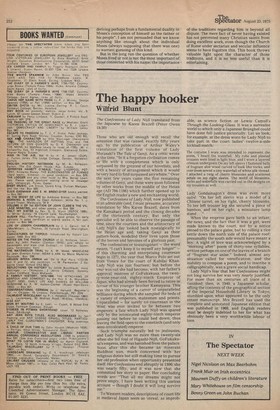The happy hooker
Wilfrid Blunt The Confessions of Lady Nijo translated from the Japanese by Karen Braze!! (Peter Owen £4.50)
Those who are old enough will recall the sensation that was caused, exactly fifty years ago, by the publication of Arthur Waley's
translation of the first volume of Lady Murasaki's The Tale of Genii. As a critic wrote at the time, "In it a forgotten civilisation comes to life with a completeness which is only surpassed by the greatest of our novelists, and. with a beauty of arrangement which it would be very hard to find surpassed anywhere." Over the next few years came the five remaining volumes of Genii, and these were soon followed by other works from the middle of the Heian age (AD 794-1186) which further opened up to the English reader a new and enchanting world.
The Confessions of Lady NO, now published in an admirable (and, I must presume, accurate) translation by Mrs Karen Brazen, dates from the Kamakura period and the closing decades of the thirteenth century. But only the specialist will be able to observe the passage of time, since the courtiers and the aristocracy of Lady Nijo's day looked back nostalgically to the Heian age and, taking Genii as their pattern-book, modelled their lives upon those of the heroes and heroines of a glorious past.
The confessions or towazugatari — the word means, "I can't keep it to myself any longer" — of this charming and enterprising courtesan begin in 1271, the year that Marco Polo set out from Venice for the court of Kubilai Khan. Lady Nija was just fourteen; but before the year was out she had become, with her father's approval, mistress of GoFukakusa, the twenty-nine-year-old, eighty-ninth Emperor of Japan, who had already been forced to retire in favour of his younger brother Kameyana. This was the beginning of a career of unparalleled brilliance during which she sampled the beds of a variety of emperors, statesmen and priests. Unparalleled — for surely no courtesan in the West was ever invited to lie between two emperors: a fate which Lady Nijo was spared 'only by the intoxicated eighty-ninth emperor passing out before he could bed down, thus leaving the field open to the ninetieth (and only semi-intoxicated) emperor.
Such triumphs naturally led to jealousies, and Lady NO was no more than twenty-six when she fell foul of Higashi-Nijo, GoFukakusa's empress, and was banished from the palace. Soon after this she became an itinerant Buddhist nun, much concerned with her religious duties but still making time to pursue her old profession when opportunity presented itself. Her Confessions end abruptly in 1306; she was nearly fifty, and it was now that she committed her story to paper. Her concluding words are: "That all my dreams might not prove empty, I have been writing this useless account — though I doubt it will long survive me."
To Western readers, descriptions of court life in medieval Japan seem as onreal, as improb
able, as science fiction or Lewis Carroll's Through the Looking-Glass. It was a surrealist world to which only a Japanese Brueghel could have done full justice pictorially. Let us look, for example, at the dress worn by Lady Nijo to take part in the court ladies' twelve-a-side kickball match: The costume I wore was intended to represent the poem, 'I heard the waterfall.' My robe and pleated trousers were lined in light blue, and I wore a layered crimson undergown.On my left sleeve I fastened balls of fragrant aloe wood carved tolook like rocks, and over them sewed a tiny waterfall of white silk thread. I attached a twig of cherry blossoms and scattered petals on my right sleeve. The motif of blossoms, rocks and waterfalls was carried out in the designs on my trousers as well...
Lady Gondainagon's dress was even more outré: "On her left sleeve was a model of a Chinese turret; on her right, cherry blossoms. To her left trouser leg she secured a piece of bamboo, and on her right, a miniature lamp stand ..."
When the empress gave birth to an infant, the news, and the fact that it was a girl, were made known to the court, not by a notice pinned to the palace gates, but by rolling a rice kettle down the north side of the palace roof; presumably the south side would have meant a boy. A night of love was acknowledged by a "morning after" poem of thirty-one syllables, written perhaps on one of the leaves of a branch of "fragrant star anise." Indeed, almost any situation called for versification, and the inability to compose a poem, and to inscribe it calligraphically, was a grave social handicap.'
Lady NijO's fear that her Confessions might not long survive her was very nearly justified. For more than six centuries all trace of it vanished; then, in 1940, a Japanese scholar, sifting the contents of the geographical section of the Imperial Household Library in Tokyo, stumbled upon what appeared to be the only extant manuscript. Mrs Braze!l has used the complete and annotated Japanese edition that was published in 1966, and English readers must be deeply indebted to her for what has obviously been a very worthwhile labour of love.


































 Previous page
Previous page